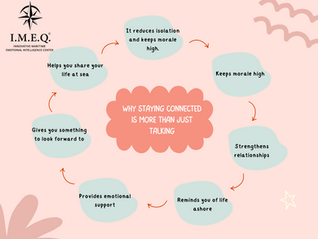Meditation, Breathing, and Mental Wellbeing: Navigating Inner Waters for Seafarers
- IMEQ CENTER

- Sep 4, 2023
- 4 min read
Updated: Sep 12, 2023

The maritime journey is more than just a physical voyage across oceans; it's a profound exploration of the self. While the vast expanse of the sea stretches before seafarers, the depths of their inner world can sometimes be neglected amidst the demands of the voyage. Meditation and mindful breathing emerge as invaluable tools, guiding seafarers towards mental wellbeing, clarity, and resilience on their maritime odyssey.
The Maritime Challenge
Life at sea is a unique blend of adventure, solitude, and challenges that demand physical and mental endurance. Long periods away from home, isolation from loved ones, and the unpredictable nature of the sea can create a complex psychological landscape. The demanding routines, combined with the isolation, often magnify stress and emotional strain. It's amidst these waves of uncertainty that the need for mental wellbeing takes center stage.
Meditation: Navigating the Inner Seas
Meditation, an ancient practice with roots in various cultures, offers a sanctuary within the confines of a ship or offshore platform. It's an inward journey that complements the outward journey, steering seafarers towards inner peace and self-awareness. Through meditation, individuals learn to observe their thoughts without judgment, allowing them to release the constant stream of mental chatter and find a serene stillness beneath the surface.
In a maritime context, meditation becomes a lighthouse that guides seafarers through the storms of their minds. It fosters a state of mindfulness, where the present moment is embraced fully. By anchoring their awareness to the now, seafarers can find refuge from the worries of the past and the uncertainties of the future. This mental anchor becomes even more valuable when faced with the isolation of the open sea, offering a constant, reliable point of reference in the vastness of the maritime environment.
Breath: The Rhythmic Tide Within
Just as the ocean's waves maintain a rhythm, the breath sustains life's cadence within us. Mindful breathing, a practice deeply intertwined with meditation, brings seafarers closer to this natural rhythm. Inhale, exhale – each breath becomes a bridge between the internal world and the sea's ebb and flow.
Mindful breathing carries a dual role – it grounds and energizes. During moments of stress or turbulence, conscious breaths become a lifeline. They steady the mind, reminding seafarers that, just like the ocean's waves, challenges are temporary and part of a larger tapestry. And in times of calm, mindful breathing serves as a way to relish the beauty of the present, a moment-by-moment celebration of life's voyage.
Mental Wellbeing: The True North
The importance of meditation and mindful breathing extends beyond moments of stress relief; they are navigational tools for maintaining mental wellbeing. Amidst the solitude of the sea, seafarers can forge a connection with themselves through these practices. Mental wellbeing doesn't mean a complete absence of challenges; rather, it's the capacity to navigate through them with resilience.
The maritime industry is increasingly recognizing the significance of mental wellbeing for seafarers. Organizations are integrating wellness programs that encompass mindfulness practices as part of their commitment to crew welfare. Mental wellbeing is not just a luxury; it's a fundamental aspect of maintaining a safe and efficient maritime operation. A crew that is mentally balanced can make better decisions, communicate effectively, and react more calmly to the unexpected.
A Beacon of Inner Strength
As seafarers journey through the vast maritime expanse, meditation and mindful breathing offer a lifeline to their inner world. Just as navigation instruments guide ships through the open sea, these practices guide individuals through the currents of their thoughts and emotions. The ability to find a moment of stillness amidst the rolling waves becomes a source of inner strength, a lighthouse that illuminates the path towards mental wellbeing.
Seafarers are not just navigators of ships; they are navigators of their own minds and emotions. Meditation and mindful breathing equip them with the tools to steer their inner vessels towards calm waters even amidst the most turbulent of circumstances. By embracing these practices, seafarers reclaim a sense of agency over their mental and emotional states, ensuring that their maritime journey remains not only a physical voyage but a profound exploration of the self.
Practice on your own
1. Find a Quiet Place:
Select a quiet spot where you won't be disturbed. This could be a room in your home, a peaceful outdoor setting, or any other location where you feel calm and undistracted.
2. Sit Comfortably:
Sit on a cushion, chair, or bench, whatever is most comfortable for you.
Keep your back straight, hands resting on your lap or knees, and your feet flat on the floor (if sitting on a chair).
Close your eyes gently.
3. Focus on Your Breath:
Pay attention to your breathing without trying to change it.
Notice the sensation of the air flowing in and out of your nostrils or the rise and fall of your chest or belly.
If you find it helpful, you can take a few deep breaths to start, then let your breathing return to its natural rhythm.
4. Be Present:
As you focus on your breath, you'll notice thoughts, sounds, or other sensations. That's okay. It's natural for the mind to wander.
Simply acknowledge whatever comes up without judgment. This might be thoughts about the past, the future, or various sensations or noises.
5. Gently Refocus:
If your mind wanders, gently bring your focus back to your breathing. This act of returning to your breath, again and again, is the core of mindfulness meditation.
Do this with kindness towards yourself. There's no need to get frustrated or judge yourself for becoming distracted.
6. Start Small and Gradually Increase:
If you're new to meditation, start with just 5 minutes a day. As you become more comfortable, you can extend this time, eventually working up to 20 minutes or longer if you wish.





































































































Comments